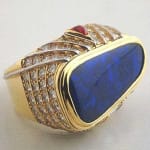Diamond Studded Gold Ring with an Opal and a Ruby
Opan, Diamond, Ruby
FJ.4231
Radiating a colorful fire from deep within, the opal has been prized since antiquity. Within its depths one sees the rich variety of colors for which other gems are famed:...
Radiating a colorful fire from deep within, the opal has been prized since antiquity. Within its depths one sees the rich variety of colors for which other gems are famed: the purple of amethyst, the red of ruby, the sea green of emerald, as well as gold and silver. The matrix for these sparks ranges in hue from milky white to bright blue to black. Mines in Hungary have produced fine opals since the Middle Ages, but the best modern source for the gem is considered to be Australia. The name of the gem is said to derive from the word ophthalmius, pertaining to the eye, and the stone is valued for its ability to avert evil. In the East, opals are much sought after as amulets to protect the wearer from disease. The stone is also said to improve the eyesight. Any person gazing upon this brilliant gem will be rewarded with beauty.
Perhaps no gem delights the senses like the diamond. This most precious of stones seems to burn with a fire deep within. Crystallized carbon, formed under tremendous pressure over millennia, the diamond is famed for its everlasting rareness. In this capacity, the gem has come to symbolize eternal faithfulness and is the traditional focus of the engagement band. Because early cultures lacked the technology to facet the diamond, the gem has only become popular in the last two centuries. Diamonds are normally colorless, but they are also found in shades including yellow, pink, and blue. In eastern belief, the diamond is said to enhance the full spectrum of energies in the body, mind, and spirit. Within the circle of gems, the diamond defines the standards of beauty, rarity, and preciousness.
Considered in the Ancient East to be the luckiest of all gems, the ruby is said to confer upon its owner protection from all misfortune either manmade or natural. Sanskrit writings refer to it as the "king of gems". In Eastern belief, it also promoted peace and prosperity for its owner, and granted him invulnerability from all evil.
Perhaps no gem delights the senses like the diamond. This most precious of stones seems to burn with a fire deep within. Crystallized carbon, formed under tremendous pressure over millennia, the diamond is famed for its everlasting rareness. In this capacity, the gem has come to symbolize eternal faithfulness and is the traditional focus of the engagement band. Because early cultures lacked the technology to facet the diamond, the gem has only become popular in the last two centuries. Diamonds are normally colorless, but they are also found in shades including yellow, pink, and blue. In eastern belief, the diamond is said to enhance the full spectrum of energies in the body, mind, and spirit. Within the circle of gems, the diamond defines the standards of beauty, rarity, and preciousness.
Considered in the Ancient East to be the luckiest of all gems, the ruby is said to confer upon its owner protection from all misfortune either manmade or natural. Sanskrit writings refer to it as the "king of gems". In Eastern belief, it also promoted peace and prosperity for its owner, and granted him invulnerability from all evil.



